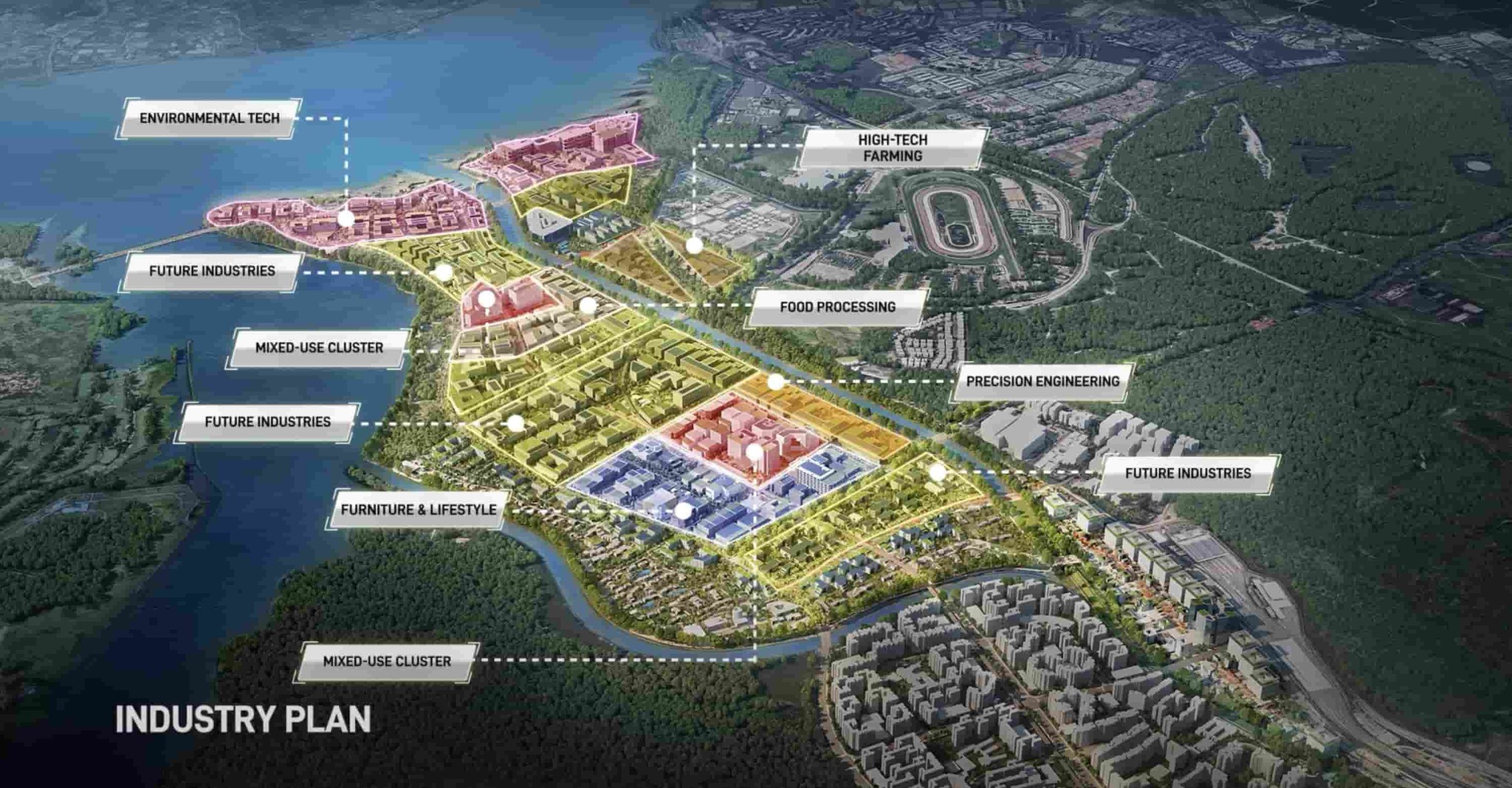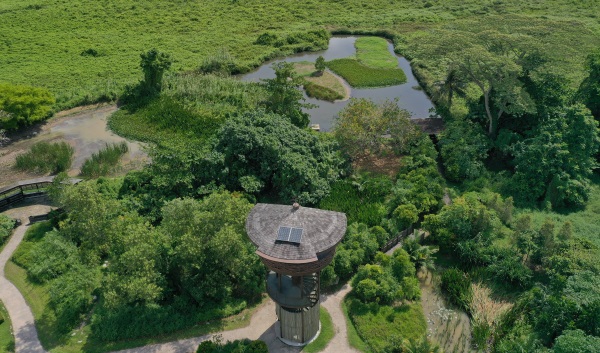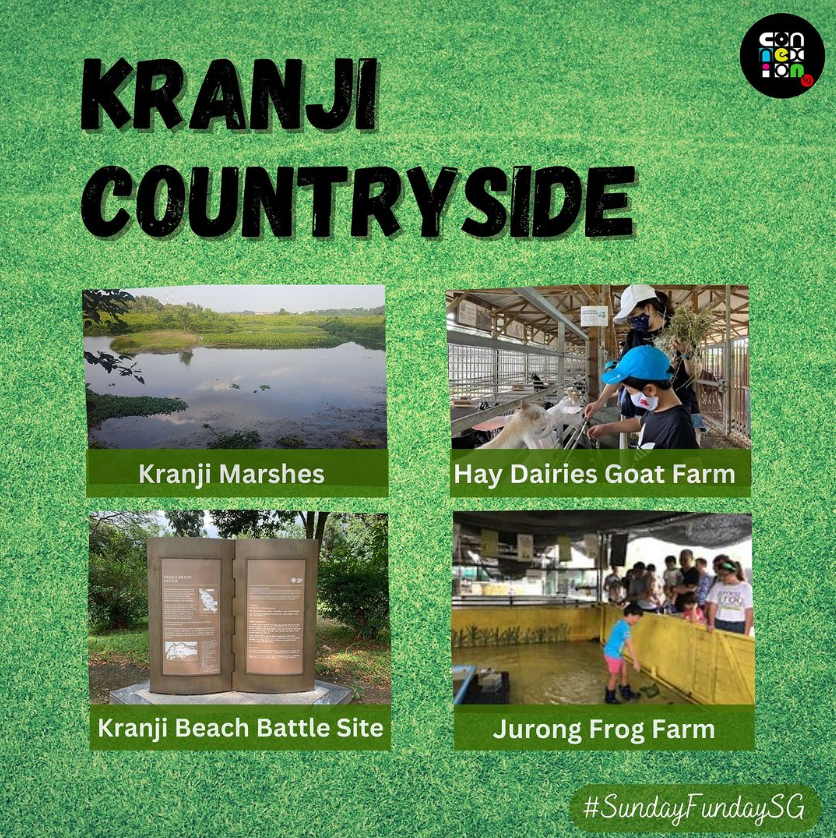Kranji

📷: Sungei Kadut Eco-District (Source: JTC Corp YouTube screenshot)

📷: Kranji Marshes (Source: URA)
Singaporeans have always known Kranji to a place of woods, and wood-works: many timber suppliers are located there, attracting homeowners in search of customised decor for dream homes.
The name “Kranji” was first known on a 1820 map by William Farquhar which showed Sungei Kranji (now Kranji Reservoir). Kranji was likely named after the pokok keranji, a local tree commonly found along the riverbanks. In the 1800s to 1900s, early Teochew migrants planted cash crops like gambier and pineapples, and developed riverside settlements known as “chu kang” (Teochew for “river port”), where the produce were processed and shipped in boats. Kampong Kranji, which was next to Kranji Road, served as a ferry station to Johor Bahru before the Causeway was built in 1923.
Kranji was a military camp before the Japanese invasion in 1942 and the second frontline where the Japanese succeeded in crossing the Johor Strait to reach Singapore. It is now home to the Kranji War Memorial and the Kranji War Cemetery, which honour the servicemen and women who died serving the country.
In the late 1960s, Kranji underwent reclamation and became an industrial estate producing wood products. Kranji Dam and Kranji Reservoir were built in 1975 to supply water to the factories.
As a suburb in northwestern Singapore, Kranji is known for its sprawling nature reserves, farmlands and wildlife activities. Kranji Marshes is one of Singapore’s largest freshwater marshes and habitat to a rich variety of flora and fauna, including more than 170 species of birds, 54 species of butterflies and 33 species of dragonflies. Together with Sungei Buloh Wetland Reserve, Singapore’s first ASEAN Heritage Park (202 hectares worth of mangroves, mudflats and forests!), they help to conserve biodiversity in Singapore.
Moving forward, the Agri-Food Innovation Park (AFIP) is being developed to combine high-tech urban indoor farming and associated research and development activities. The AFIP will be located within the Sungei Kadut Eco-District to form part of the larger Northern Agri-Tech and Food Corridor with food-related industries. Our manufacturing sector is also being renovated there, with high-tech clusters of closed-loop systems in which one company’s waste gets regenerated as another company's resources: transforming waste management and recycling, metal, timber and the furniture industry. Kranji Water Reclamation Plant and Kranji NEWater Factory will be redeveloped by around 2035 to increase their treatment capacity to cater to industrial developments in the north of Singapore.
There are also plans for redevelopment in the area vacated by the Singapore Turf Club from 2027 onwards. The site is earmarked for housing and community facilities, and will support the development of Woodlands Regional Centre as Singapore’s largest northern economic hub. With more recreational activities and community spaces injected into the area, Kranji is the launch pad for a lifestyle in lush and sustainable surroundings -- where the future is made better, by design.
#OurNeighbourhood #Singapore #Kranji
_______

Located in the northwestern part of Singapore, the Kranji precinct is where you can experience the great outdoors on a #SundayFunday. With farms, lush nature reserves and wildlife, you can expect to see a different and more peaceful side of Singapore in this sprawling rural area.
Kranji Countryside isn’t just limited to Kranji. More accurately, it covers Lim Chu Kang which is where the farms are located, and the Western Water Catchment Area, which is what they call the area encompassing reservoirs found on the west coast of Singapore.
Looking to take a break and maybe catch a beautiful glimpse of the Johor Bahru Straits and skyline? Then head to the serene dwelling of Kranji Reservoir Park. Then head down to Kranji Marshes to explore its natural beauty. With various natural habitats such as woodlands, marshes, and grass habitats, you can expect to see a wide array of animal species such as birds (exotic and migratory), monitor lizards, dragonflies, butterflies, and more.
History buffs can drop by the Kranji Beach Battle Site and learn about the darkest Singapore war history and battle. The battle site was the defence site of Northwestern Singapore during World War II against the Japanese invaders.
Animal lovers can choose to feed the cutest little goats at Hay Dairies, meet the frogs at Jurong Frog Farm, or get your hands dirty at Kok Fah Technology Farm.
With so much to offer, Kranji is where you can explore the countryside and get to know nature beyond the concrete jungle.
Do note that the attractions are quite far apart from one another. Hiring a private van charter or booking a tour package would bring convenience as you could cover many places in one day easily - a great option for those of us who don’t drive.
#SundayFundaySG #SundayFunday #Kranji #KranjiCountryside #RuralSingapore #KranjiMarshes
#KranjiReservoirPark #GoatFarm #FrogFarm #SingaporeVisit ConnexionSG Facebook& Instagram for more content.

